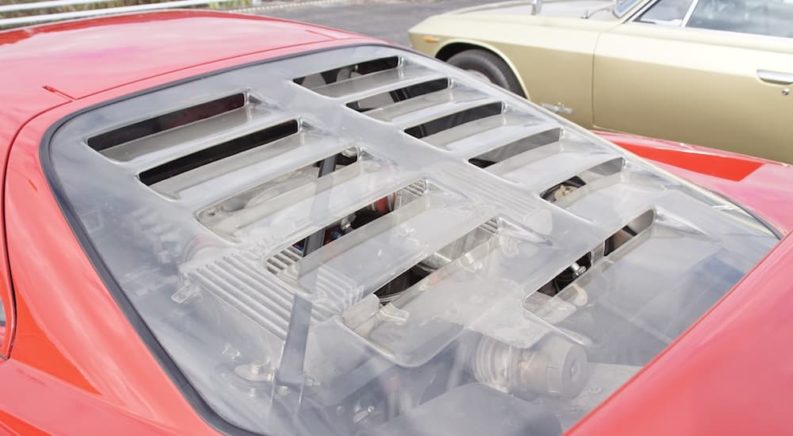Virtually any list of the greatest sports cars of all time includes at least one Ferrari. The marque is one of the strongest brand names in the world, earning its recognition through racing excellence and a sports car division that exists solely to support said excellence; it’s requisite for such a brand to be a builder of legends. But if you were making a shortlist of the greatest sports cars ever and had to pick just one Ferrari to include, which would it be?
There are many candidates, from classics like the 250 GTO (the most expensive car in the world) to any member of the “hypercar series” (288 GTO, F40, F50, Enzo, and LaFerrari), depending on one’s criteria for greatness. For some, the criteria are objective: price, rarity, achievements, and performance numbers. Others look to cultural milestones like the first, the last, and the most representative of the times. For many, the summation of it all points to one clear Rosso Corsa champion: the Ferrari F40.
An example of this car was sold at auction on November 5, 2022, as part of the Gran Turismo Collection alongside its four hypercar series stablemates. A cool £1.4 million ($1.7 million) was enough to transfer ownership of chassis 88895 out of this remarkable collection, which featured 18 of the most incredible performance cars of the last 40 years. Here, as part of a series covering these vehicles, I take a look at what the F40 was, what it meant, and how chassis 88895 stood out in a very special (and unusually large) crowd.
The F40 Identity: If the 1980s Were a Car
The F40 is arguably, if not objectively, Ferrari’s greatest commercial success. It’s a style icon, a performance masterclass, and the very last model to receive Enzo Ferrari’s precious blessing. Yet it almost didn’t happen at all!
The story of the F40’s improbable development and incredible success is vintage 1980s; it’s even rooted in failure, making it a classic comeback tale! That’s because the F40 traces its origin to Ferrari’s failure to produce the 288 GTO Evoluzione for Group B before the notorious rally racing class was eliminated by the FIA. Engineer Nicola Materazzi salvaged the project by pitching it as groundwork for a hardcore road car to celebrate Ferrari’s 40th anniversary; Enzo agreed to this, giving his team barely a year to take the car from concept to production in time for the milestone event.
The incredibly aggressive development schedule forced engineers to develop the suspension and chassis in parallel with the drivetrain; the result is universally praised despite the disjointed dev cycle. Pininfarina used the time to refine their Evoluzione bodywork in a wind tunnel, leading to the F40’s distinctive wedge body, covered in arrow-shaped inlets and finished with a massive integrated spoiler. Incredible efforts were spent to minimize the mass of every component, and no compromises were made to improve comfort.
The result was a 3,000 lb curb weight, a 4.2-second 0-60 mph time, 1.01 g road holding on a skidpad, and a claimed top speed of 201 mph, making the F40 the first production car to surpass the 200 mph mark! Sure, these numbers don’t exactly stand out among today’s supercars, but in 1991, when Car and Driver tested it, these were the most extreme performance numbers they had ever recorded.
The Right Car at the Right Time
The F40’s successor, the Ferrari F50, is arguably the Ferrari that the world deserved in 1987. It’s a more valuable car today because it’s much rarer and is several steps closer to being a race car for the road, which was the F40’s ultimate objective. But at the time of the F50’s release, its impact was muted––the economic climate, its polarizing style, the absence of Enzo Ferrari’s signature, and a negligible performance jump from the F40 dampened the world’s perception of the F50 for years.
By contrast, the F40 was the Ferrari that the auto world needed, becoming so successful as to be unsustainable. It was a massive performance leap from the 288 GTO, with perfect economic timing and smash-hit styling that put its poster on every car fan’s wall for more than a decade. It was a good job that Enzo pushed its production schedule––he passed away the year after its release, having just witnessed the ultimate realization of his life-long vision. Perhaps this was a mercy because, like everything else about the 1980s, the F40’s heyday was a party and the hangover was nasty.
Its title as “fastest production car” was short-lived, quickly surpassed by the Porsche 959 S, and no official test has ever verified the stock F40’s ability to actually achieve 200 mph (Car and Driver enthusiastically confirmed at least 197 mph). Then there was the rabid market, which pushed Ferrari to produce 1,311 examples, making this Ferrari’s most common “hypercar” by a mile and reducing its value. The fervor also led to ridiculous speculation with several hundred percent markups, which saw the car transformed from automobile to meme-like investment commodity and set a lot of people up for a crash.
When the frantic 1980s market finally took a downturn, F40 values plummeted, and furious speculators somehow blamed Ferrari for their losses. The legacy of this would be the infamous F50 sale process, which introduced us to customer screening and lease-only purchase options, through which Ferrari controlled (prevented) serious testing that could challenge their performance claims.
In summary, the long-term effects of the F40 haven’t all been good, and there were several lessons learned by all involved. But this downside seems largely forgotten as we now see the F40 through Rossa Corsa-tinted glasses and idolize it more than ever for representing a tremendous leap from the preceding era. Thus the F40 is a manifestation of the 1980s zeitgeist, an era of excess and excitement for which many still yearn––and when you read the testimonies of those who’ve driven it, it’s easy to see why.
Translating Specs Into Feeling
There’s a lot of technical jargon to sling around regarding the F40. It was built around a 2.9L twin-turbo V8 making 478 hp and 424 lb-ft of torque. It had a $400,000 MSRP and a 50-page owner’s manual that could communicate everything you’d need to know in four languages. It also had a mere 11 body panels––all made of Kevlar-carbon fiber composite (a first-in-the-world claim)––three different keys needed to operate plentiful locks plus ignition, a 10-year lifespan for the two fuel bladders, zero door handles on the interior, and a 3,000 lb curb weight achieved by taking every possible opportunity to reduce mass.
For reviewers, little could be more enticing or terrifying than driving the million-dollar icon. Yet compared to other classic supercars––incredible but heavily compromised vehicles that often attempt to murder their drivers on a whim––the F40 is surprisingly accessible. It’s planted and stable even on bumpy freeways, with kart-like steering and well-controlled power delivery. Almost, but not quite, enough to make you forget you’re driving one of the flashiest cars on the planet.
The function-only aesthetic ensures that such a slip-up never happens. Bare carbon almost everywhere, a mediocre climate control system (AC was standard but ineffective), snug bucket seats, and the open strakes of the Lexan engine cover leave no mistake as to the car’s true identity. When you slip behind the wheel, the sound, the feedback, and the demand to be driven overwhelm everything else. In the F40, there are no distractions, not even a radio––it’s just you and the car.
Chassis #88895
It isn’t often that I get a chance to reflect on more than spec sheets and high-octane track tests of brand-new cars. The RM Sotheby’s auction of the Gran Turismo Collection in November of 2022 gave me just such a chance, so I jumped at the opportunity to discuss the industry’s greatest modern designs with the perspective of their real-life stories, one of which belongs to Ferrari chassis 88895.
Built in early 1991, chassis 88895 came along in the latter half of the F40’s run, long after Ferrari swapped the windows and windshield from Lexan to glass. Built to the European specification, it has less power but smaller bumpers, a cleaner look, and 160 lbs less mass than its American contemporaries. Many F40s were immediately mothballed by speculative collectors, ultimately leading to “storage syndrome” from disuse––fortunately, 88895 is among the lucky ones to avoid this fate. The car saw a whopping 157 miles a month during its first few years cruising the northern Mediterranean coastline before joining the Gran Turismo Collection in 1997.
This car bears the rare distinction of being a collision survivor (too bad for the car, but lucky for us that it survived), leading to the replacement of the front and rear clamshells. Accounting for more than half of the F40’s bodywork, I shudder to think of what that cost! But that did not deter the vehicle’s second owner from using it regularly; by the time Sotheby’s received it, it had over 30,000 miles on the odometer, making for nearly 100 miles a month!
If you ask me, racking up that many miles is pretty good for any supercar in an 18-car garage. The Gran Turismo Collection’s former owner sounds like a passionate driver at heart, someone who kept the cars running for all the years they were together and used them for all they were worth. This F40 was not exempt from the attention; despite many alluring alternatives being available, it still accumulated hours of far-from-luxurious drive time on a regular basis, experiencing all the miles that one of Ferrari’s greatest creations deserves. I can only hope that this steady pace continues with chassis 88895’s third owner.
The GOAT?
I view the F40’s legacy as a complex one. I question its vaunted position as the swan song of the analog performance car––the F50 is closer to a full-F1 specification, and the F40 doesn’t command the earth-shattering auction pricing of rarer contemporaries. By caving to consumer demand for more cars, Ferrari learned painful lessons through the F40, which would transform the hypercar industry, arguably for the worse. That being said, the car was a slam dunk in the styling and performance departments, making the F40 a massive leap from its predecessors, placing it ahead of its competition and perfectly capturing the zeitgeist of the 1980s.
Arriving at the end of his legendary career, the F40 became Enzo’s greatest achievement, and the precise feeling it inspired will never be replicated. We’ll never again witness such a performance achievement in such a demanding, analog vehicle, simultaneously setting a design benchmark while inheriting instant nostalgia value as the last product of an automotive titan. For this reason, the Ferrari F40 should continue to rank among the greatest sports cars of all time––forever.




